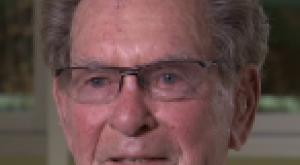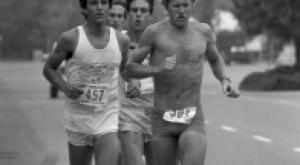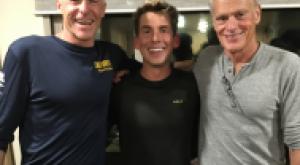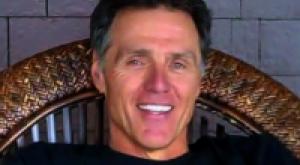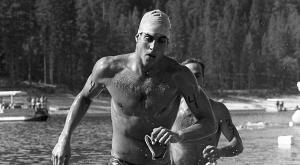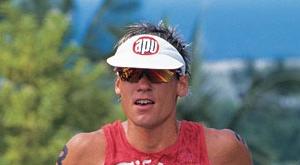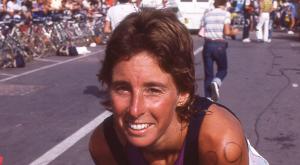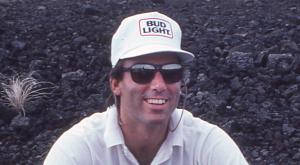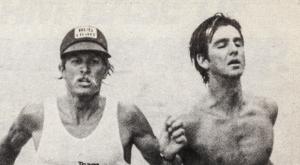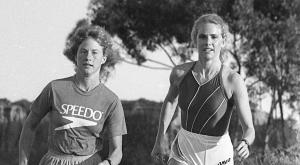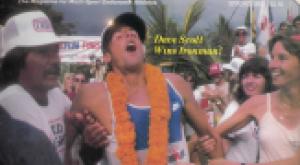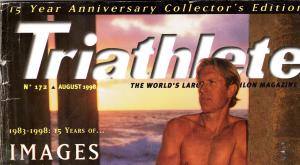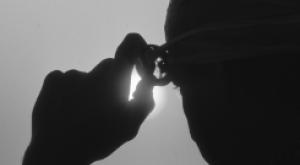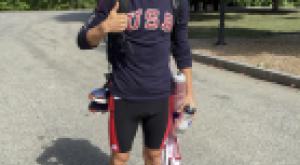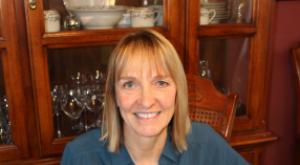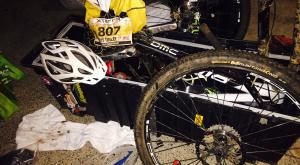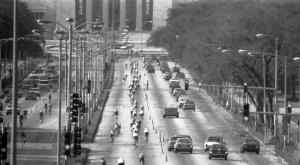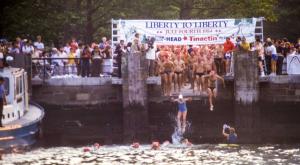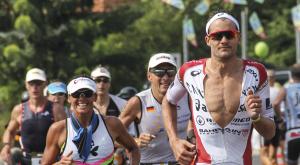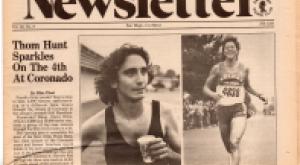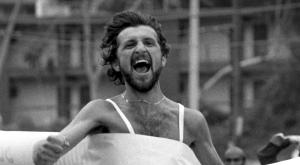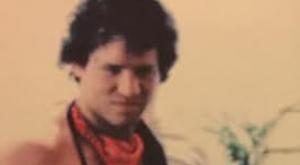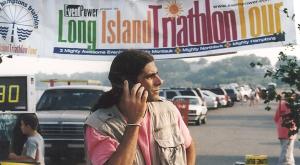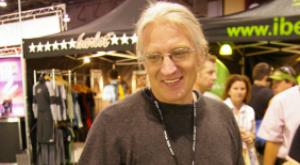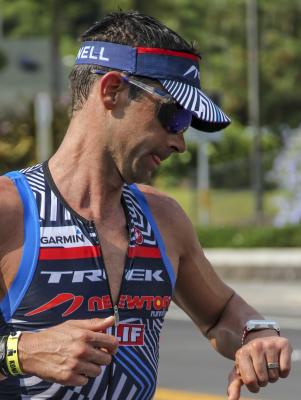
Tim O'Donnell, with about a mile to go. He will finish in third place, wobbly, but happy, at the end. If TO and his coach Mark Allen have it right, there are more and bigger things to come. (Photo: Mike Plant/Tri-History)
By all accounts, the performance of 35-year-old American triathlete Tim O’Donnell at the 2015 Ironman World Championships in Kona was a breakthrough – especially so on the bike. There was a discernable note of surprise in the race-day coverage when O’Donnell went strongly to the front on the way down from the turnaround at Hawi. And in interviews after the race, O’Donnell admitted to sharing in that surprise – at least a little. Suddenly, there he was in front. What now?
For O’Donnell, it was a take-or-leave-it moment. There was hesitation in the field after early leader Ben Hoffman had been caught and passed; it was someone’s turn to step up, step in, so O’Donnell picked up the flag and pedaled on. “I just said to myself, just ride your ride,” he told Triathlete magazine, “ride what you’re capable of doing. I felt great.”
O’Donnell didn’t stay in front all the way into town, but he stayed close, then ran in second place for the first half of the marathon, a little more than two minutes behind the leader Jan Frodeno. Then things got interesting.
Watching the race updates on my phone, I saw that O’Donnell had closed the gap to a little more than a minute coming put of the Natural Energy Lab. Either that, or Frodeno was cracking. But the gap re-opened quickly, then widened, and before long, O’Donnell was asking folks along the course about the German, Andreas Raelert, who was in third. It was a sure sign that O’Donnell was done, that his fate was now in the hands of the course, the gods of the Big Island, the long day of racing, the man coming hard behind. His brief shining time in the driver’s seat of the Ironman World Championships had passed.
I couldn’t help but ponder in that moment what O’Donnell’s coach, the legendary Mark Allen, was thinking.
The most naturally talented triathlete of his day, Allen struggled through a years-long gauntlet of failure and frustration in Kona – including a mechanical failure in his first attempt at the race in 1982 -- before finding a workable formula for success, the final pieces of which lay not in his training or technique, but in his mind. Even before he won the race in 1989 he was known as “The Grip” and the “Zen Master” for his ability to take his body places where few of his contemporaries could, or even dared. Allen’s legendary “Iron War” race with Dave Scott in ‘89 was a master class in focus and single-minded concentration – eight-plus hours of locked-in, tunnel-visioned competitive intensity designed to achieve a single outcome. The record books show that Allen’s 2:40:04 marathon that day has yet to be surpassed. What the books do not, and cannot, record was the precise, almost surreal way in which that time, and every other portion of the race preceding it, had been visualized and executed.
So with Mark Allen in mind, I wondered: Was O’Donnell’s near miss in 2015 the all-given, nothing-left proposition it seemed to be, or was there a final layer of mental performance yet to be added – a layer only a guy like Mark Allen could identify and coax out an already superb athlete?
I figured the best way to find out was to go to the source, to Mark himself. I had not planned on an extended Q & A. I was just looking for a comment or two. But the insight Mark offered was too good, and the interview ranged beyond the 2015 race itself into areas that I felt a lot of competitive triathletes would like to hear – and things that will still be on our minds when O’Donnell steps into Kailua Bay for the start of the race in 2016.
Here’s how it went:
MP: First of all, what was your thought about the conditions in Kona this year?
MA: It was one of the hottest I remember. Part of it was the heat, part of it was that there was no cloud cover. Any time there’s no cloud cover it just intensifies the heat. All you have to do is look at the marathon times and you can see it was hotter than normal.
MP: So for a while during the marathon, as you know, it looked like something special was going on with Tim. He got within a minute, right?
MA: Well, he was in the lead on the bike for 30 or 40 miles. It was the longest an American’s been in the lead since (Chris) Lieto used to go off the front. Then, finally, Kienle and Frodo caught him – which was good. He was just kind of out there, you know? He said he wasn’t pushing the pace. Nobody was coming. He kept looking back, wondering where everybody was. But he felt good. His legs felt really good.
Then, at the last aid station – about 10 miles out -- he didn’t get any water. He went through, and the people at the aid station didn’t run, and he didn’t slow down enough, and he didn’t get any water. So all of sudden he was boiling over. He had to let Jan go at that point. It just wasn’t worth it.
So he got a little behind right there. And then he started the run, and he had this flask with all his calories for the first 15 miles; he had it in his mouth, held by that little nipple thing that pulls out, you know? Anyway, that nipple pulled off and his stuff goes flinging on the ground and rolled under a barrier. He was able to grab the flask, but now there’s no top on it, and all his calories were just sloshing out. So he got behind on calories the first part of the run, and he paid the price for that.
But all in all he was psyched. I mean, it was the first time he’s really been in the mix of the race all the way through. Now he knows what he can do. It’s just a little bit more tweaking. First thing we talked about after the race was, “Ok, 2016: TO Version 2.0.”
MP: Were you surprised – it seemed like he was surprised – to find himself in front on the bike?
MA: We talked strategy before the race, and we realized that there are so many different scenarios that can happen, there was just no way to think of all of them. So the main goal was to come out of the water in decent position, then try not get any further down than 5th or 8th on the bike– you know, stay at the front of the guys., because the further back you get in that pack, it’s just impossible to respond when the moves start to happen. You have to go way too hard. So he wanted to be a little bit more aggressive and stay up in the front. But when he went through Hawi, he just kind of moved up to the front and went through the turnaround first, knowing that a lot of those guys really put the hammer down on the downhill with the tailwind. If somebody gaps you there, it’s very hard to make it up, because they’re going 50-55 miles an hour. What are you going do -- 60-65 to close it? There’s just no way.
He wanted to be able to respond immediately if somebody really started to go. It wasn’t part of a plan to be at the front; it just happened. And then nobody was coming through, you know? He had this gap of 45, 48 seconds that lasted for a long time.
I was out there with NBC, but we didn’t go up to Hawi, so I kind of figured it was just happenstance. It wasn’t necessarily anything he was trying to do. He knows that he can run, so there was no need to put a five-minute gap on anybody on the bike to feel like he could win it.
MP: The fuel thing is interesting. When did he break his bottle?
MA: Right at the beginning of the run, coming out of transition. He lost about a quarter of his calories. He was trying to make it up with other stuff, but that just doesn’t work – not at that level. You need your stuff. One of the things was that his sodium was in it, so he wasn’t getting enough sodium
But you know, to win Ironman you’ve gotta hope that pretty much everything more or less goes your way. And if doesn’t, that there’s a way to make up for it. Sometimes shit happens that you don’t plan on. Depending on where it happens in the race, it can be very hard to make it up.
He was still totally pumped. He knows what he can do on the bike. His running was really starting to come around toward the end of the summer. We both know what’s in the tank. Now it’s just matter of working hard off-season, and continuing on with the progression next year.
MP: So here’s my big question. I saw that Tim was closing on Jan in the marathon, and then the gap opened back up. A while later I saw a blog on someone’s post that Rinnie (O’Donnell’s wife and two-time defending Ironman WC champ Mirinda Carfrae) had gone back out onto the course, and at one point Tim asked her how far behind Andreas Raelert was. That’s when I thought of you.
And the bottle story is interesting too.
I realize there’s only so much the body can do, but of all people you’re the one who’s gone farther than anyone beyond that. I was interested to know if that was part of your discussion with Tim after the race? Did he let the bottle thing bother him? Did he get close in the marathon and then not have it in him – mentally – to finish the job? Is that part of what you’ll be working on in Version 2.0 – the kind of thing you did with yourself all those years? As you know so well, the physicality of the race has to be perfect, but so does the mentality.
MA: He managed it all really well. It didn’t derail him mentally. He dealt with everything perfectly. When he didn’t get water at the last aid station on the bike, he slowed it down, because he knew. And (with his calories on the run) he tried to make up as best he could with what was on the course. And that’s it. It didn’t throw him off.

Knowledge transfer: American Tim ODonnell in Kona in 2015 and his coach, Mark Allen, three decades before, on the same course. Starting with a mechanical failure in 1982, it took Allen seven years and six attempts to get Kona right. By the time he did, his mental game was as sharp as his incrediible physical skills. Now Allen's focus is helping his star pupil climb to the top of the Big Island podium. (Photos: Mike Plant/Tri-History)
But we worked, actually, on some of the other stuff – with mindset. When you’re coaching an athlete, it takes a while to figure out a couple of things. One of them is how their body responds to what I think is the ideal training. It took all of last year, going through all the different phases of training, giving him what I thought was right, and him responding. We needed to find what his tolerance was for volume and intensity, so I could give him just the right amount, but not too much
It also takes time to figure out what can be improved about an athlete’s mindset, their focus. And those are really subtle things – including how they approach things day-to-day. You can’t be one way 364 days a year, then all of sudden be completely opposite of that on race day in Kona. You have to be adopting certain ways of doing things -- ways that set you up to be the best on that day.
It took a year-and-a-half of getting to know Tim and seeing how he’s hard-wired to figure out areas he could improve on, based on how he was able to focus. Some of that was me, and some of it was him discovering it himself. That’s the real goal for an athlete: to have enough awareness to be able to see what’s going on – both in their training and in their racing – and be able to say, “When I focus this way I do really well, and when I focus this other way, I don’t do well.”
We dialed a couple of key things in there, and I think that was another factor this year. And it’s obviously something we’ll carry forward.
MP: There are some athletes that just don’t have that next level in them. They may have the physical talent, but they don’t have the mind. It sounds as if Tim has it all.
MA: The first time I ever saw Tim, he wasn’t racing Kona, he was there supporting Rinnie. I’d gone into this little health club on Palani Road. I was just doing some strength training, and TO was in there, doing his routine, and he had this focus on what he was doing. I thought, “You know what? This guy could freakin’ win Ironman. He’s got it.”
At that point I’d never even met the guy. But you could just see it. I could see it. I’m still waiting to prove myself right, but we were pretty close this year, so…
But yes, there is just no way some athletes can step up mentally; they can do all the training, but they’re just not going to pull it together on that internal level. You look at a guy like Jan Frodeno: he said in one of post-race interviews that going for a gold medal helps teach you how to focus all your energies into one day. Obviously, he has that. He knows how to do it. He’s proven that he can do it. But not every one of those guys in the top 10 or top 20 can do that, even though they have all the other tools in the shed.
MP: Not to get off track, but I have to mention Tim’s wife as being someone who doesn’t seem to have a mental limit at all – on top of having tremendous physical ability.
MA: If there was a definition of perfect running form they’d have a video of Rinnie. It’s really incredible to watch her run in Hawaii. On the bike she doesn’t look like anything spectacular, but then she gets off that bike and her run mechanics are as perfect as you could possibly get. Plus the mindset, and the way she goes for it; the way she goes to it.
I’m working… my goal for 2016 is to try and see if we can figure out a way to get Rinnie and TO across that finish line in first place in Kona. It’s very hard for couples to both win on the biggest day of the year, together. Look at Lori Bowden and Peter Reid. One would win, the other would win, one would win, the other would win. Then finally, the year they called it quits -- right before Kona -- they both won it. But they couldn’t celebrate that together.
I know it can be done, but it takes some extra planning…(Mark made this last comment thoughtfully, his voice tailing off at the end. I could hear the wheels turning, but chose not to press the issue. I and everyone else will have to wait until 2016. Certainly adds a dimension, though, doesn’t it?)
MP: I don’t know either athlete personally, but I’ve heard they have a great relationship.
MA: Rinnie & TO are great together. Last year, after Rinnie won and TO had to walk and ended up 32nd -- when they finally saw each other, you could see this heartfelt disappointment she had for him. It had nothing to do with, “I won, and oh well, he didn’t do so well.” She cares about the guy, and he cares about her. It’s really cool to see that. It’s rare.
MP: Getting back to the race, when Tim gained ground on Jan, and then dropped back again, did you feel as if Tim had done all he could at that point, that Jan just had a bit more in the tank?
MA: TO was not holding back. He gave it everything he had. And he gave it everything he had to hold off Raelert as well, which was for quite a while, actually. Even when Raelert went by he tried to stick with him.
For me it’s pretty exciting, because it’s much, much easier to work with somebody who’s been in the hunt, been in the lead, been able to close gaps on the run against somebody who was pulling away – but who just didn’t have it the last 10K.
It’s much, much easier to take that and give it that final touch, than it is to have somebody who maybe got second, third, fourth, fifth – almost by default. Someone who, at the end of the day, was very steady while everyone else kind of cratered in front of them. That’s a bigger ask – to figure out how you’re going to bring that second kind of person up be #1.
There are no guarantees at Ironman. The real challenge next year is Tim not trying to race 2015 again in 2016. You have to be ready for a completely different dynamic. We’ll continue to broaden his base of fitness, so that he can hopefully cover anything that does arise, but that didn’t arise in 2015.
MP: It all seems much more scientific than when you were racing. Is that true?
MA: Kind of. A lot of the training is much more scientific. I don’t know if it’s helping anybody, necessarily. But people are looking at a lot more numbers now than when I raced. Which dials in a certain aspect of your fitness. However, I think it makes it so that you are relying on the numbers more than anything. It’s easy to forget to develop that intuitive sense about your body that you really need when you’re in those impossible moments, like “How am I going to pull this out?”
No number is going to give you the answer.
Nutrition, calories, all that: it’s pretty dialed in now, especially compared to what we were dealing with. We were still kind of experimenting. But it’s still a little bit of a crapshoot, because a lot of people still get sick to their stomach, they get bloated, they have all the calorie numbers right, but in a race like Kona, where it’s really hot and humid, and you’re under this huge stress, your body doesn’t work the same, so the calories don’t either. So there’s still a little magic to it – for me, anyway.

